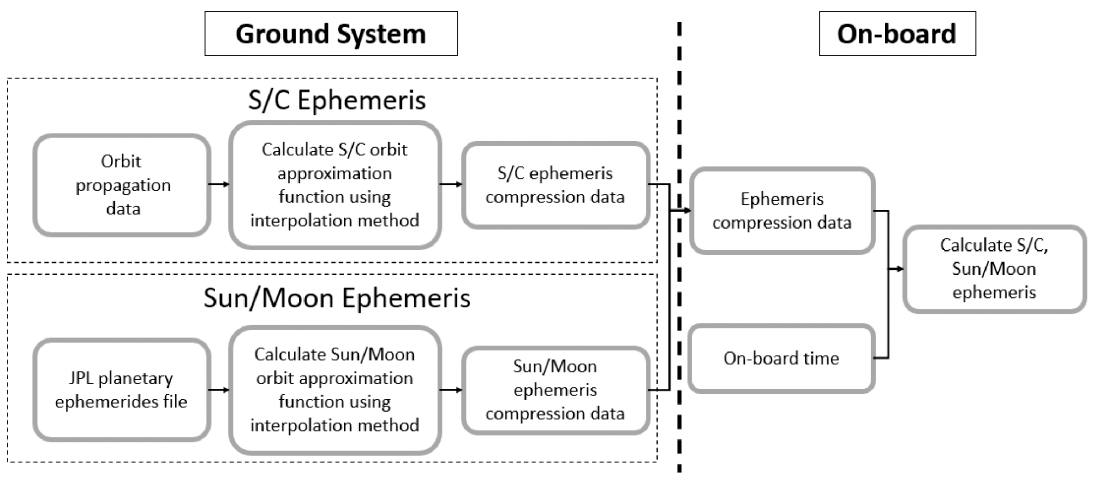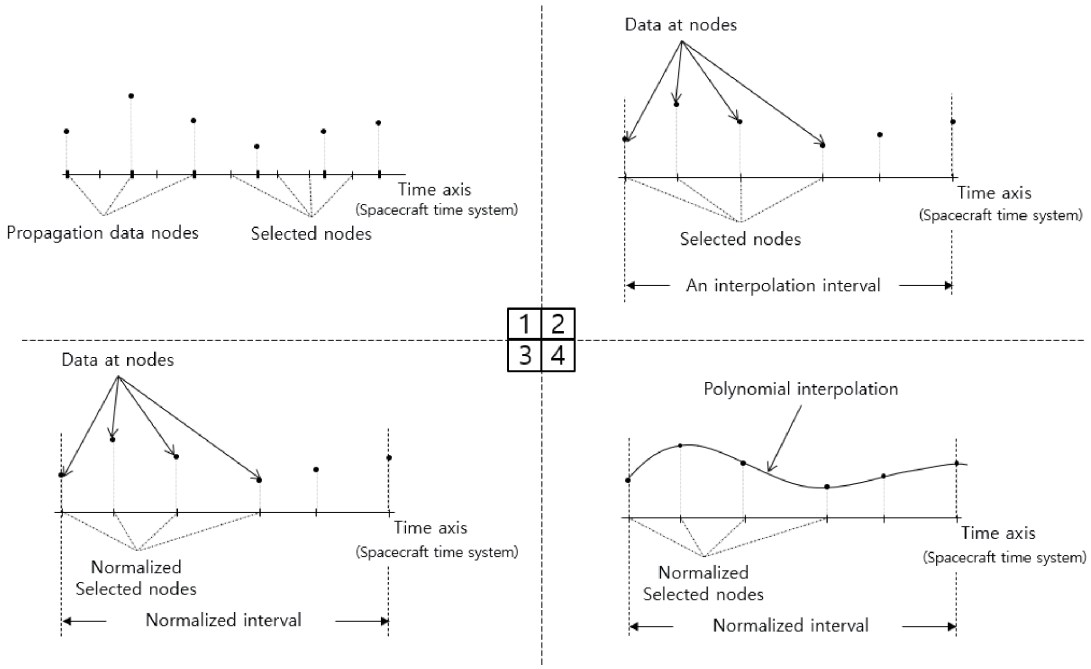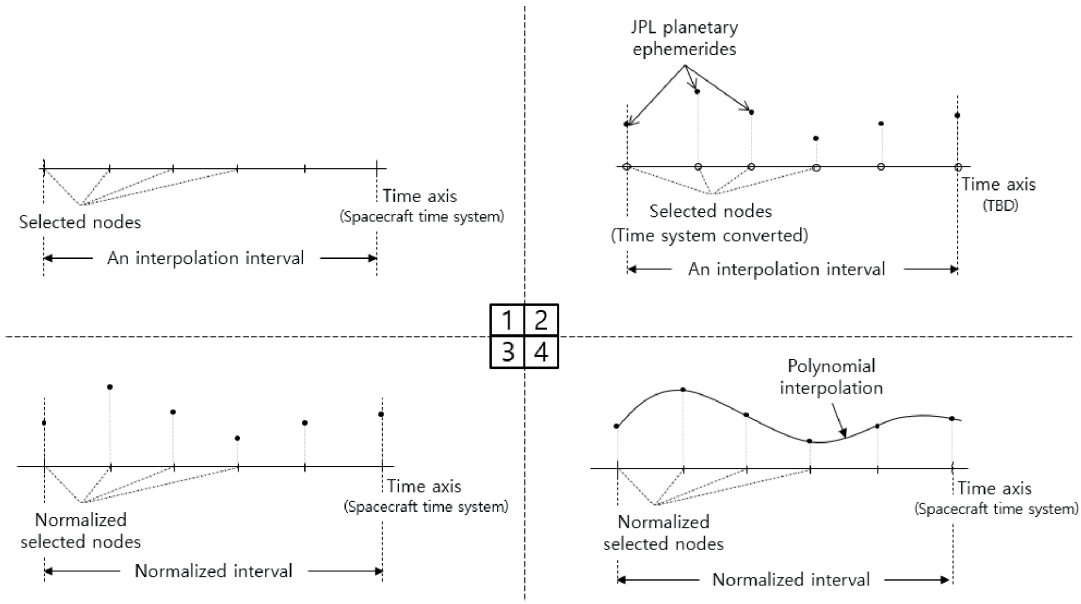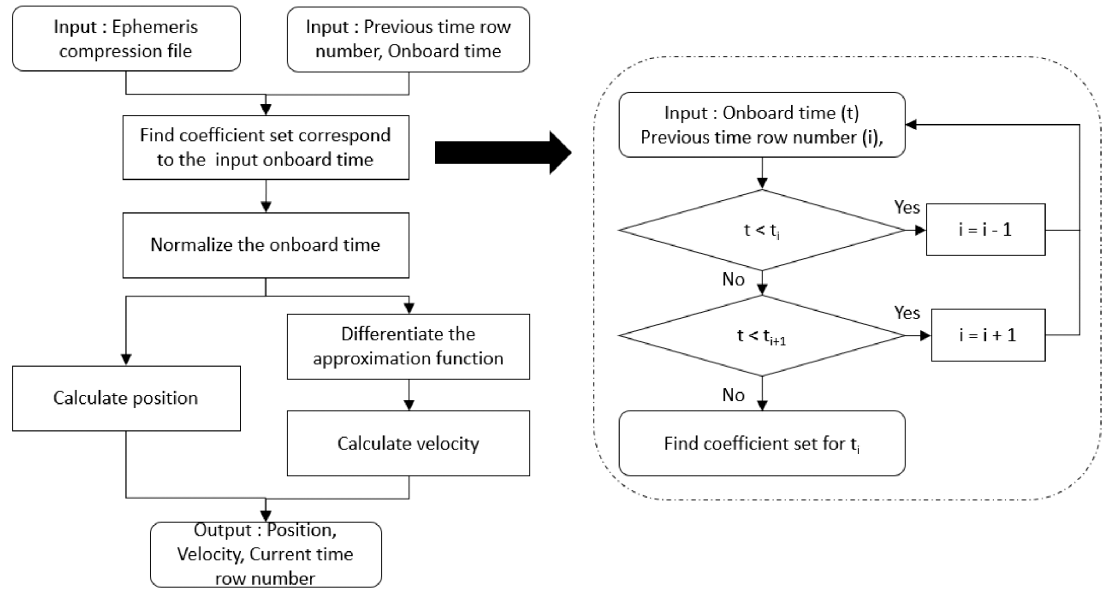1. INTRODUCTION
Korea Pathfinder Lunar Orbiter (KPLO) is the first lunar spacecraft of Korea which will perform its missions over 100 km above the Moon’s surface in 2022 year (Ju 2017;Lee et al. 2017;Kim & Song 2019). The KPLO has several tasks, such as taking images of lunar surface, investigating lunar magnetic field distribution, radiation and surface compositions in polar orbits of the moon. For these purposes, the KPLO must be able to point to specific locations whenever needed. Furthermore, the solar panel must be oriented toward the Sun and the communication antenna must be directed to the Earth. To perform these orientations, the position of the spacecraft itself, the position of the Sun, and the position of the Moon should be calculated in the spacecraft’s onboard. The computation of the position of these space objects is called the ephemeris calculation. There have been many researches of onboard ephemeris generation for lunar exploration missions. For the Apollo missions from 1969 to 1971, coasting integration routine with Enke’s method was used to calculate the ephemeris of the spacecraft (Savely et al. 1972). In the case of the Sun and Moon ephemeris, an erasable memory was loaded showing 1° error for a year observed from the Earth (Savely et al. 1972). For Lunar Prospector mission in 1998, FDD (Flight Dynamics Division) in ground system sent data of the spacecraft and the Sun/ Moon/Planet ephemeris data (Andolz 1998). For GRAIL (Gravity Recovery And Interior Laboratory) mission in 2012, ephemeris data were sent to the spacecraft in Chebyshev polynomial coefficient form from the ground system (Antreasian et al. 2012). For Chang’E mission from 2007 to 2013, VLBI (Very Long Baseline Interferometry) system was used to get orbit determination data (Wei et al. 2015).
By referring these research, a KPLO ephemeris generator has been developed by using a kinematical method. The kinematic ephemeris generator is made by utilizing the ephemeris compression method of the NASA JPL planetary Ephemerides (Newhall 1988;Folkner et al. 2014). A kinematic ephemeris generator equipped in onboard computer of spacecraft generates spacecraft’s ephemeris at a desired time, by using uploaded information from a ground system in the Earth. Generally, the uploaded data are spacecraft’s orbit propagation data that contain time, position and velocity values in tabular form, which means it only contains information in discrete time. Saving all of this tabular data requires a lot of memory. Therefore, JPL planetary ephemerides provides only the coefficients of the orbit approximation function and the Lagrange multiplier method as an approximation function in order to calculate desired approximated ephemeris when needed. This tool can approximate orbit in the error of 0.5 mm (Newhall 1988). The ephemeris compression method of JPL planetary ephemerides has good performance in terms of accuracy but has a disadvantage of large data budget. In this method, Lagrange multiplier method is used to find the optimal approximate function and it uses information of both the position and velocity at a given node and boundary conditions. Therefore, the size of coefficients data be saved is large because it requires high order approximation function whose order is larger than the number of nodes given. Also, since only the position error is given for the requirements, using velocity information unnecessarily increases the accuracy by increasing the amount of the coefficient.
For the KPLO mission, an important constraint to be considered in developing a kinematic ephemeris generator is the limitation on the size of the ephemeris compression data because of limitation on onboard computer capability. Thus, a kinematic ephemeris generator for the KPLO has to utilizes a method of interpolating the position information only. The main contribution of this study is that a kinematic ephemeris generator algorithm based on very limited conditions for the KPLO is developed and validated. The algorithm consists of a ground ephemeris compressor and an onboard ephemeris calculator. The ground ephemeris compressor compresses spacecraft’s ephemeris and celestial bodies’ ephemeris in a ground system. This algorithm should be interfaced with a flight dynamic software of a ground system for a lunar mission. The onboard ephemeris calculator generates spacecraft’s ephemeris the Sun/Moon ephemeris at a desired time in an onboard computer of the KPLO, by using uploaded compressed information from ground system. The developed algorithm will be used for the KPLO mission.
In Section 2, an architecture of the kinematic ephemeris generator is presented for the KPLO. In section 3, the ground ephemeris compressor in a ground system is explained for spacecraft ephemeris and the Sun/Moon ephemeris. In section 4, the onboard ephemeris calculator for calculating the ephemeris with the compressed ephemeris data is introduced. In section 4, the kinematic ephemeris generator is verified by many numerical simulations. In the section 6, conclusion of this study is made.
2. A KINEMATIC EPHEMERIS GENERATOR FOR THE KPLO
For the KPLO mission, a kinematic ephemeris generator is developed by referring the planetary ephemerides by NASA JPL. The ephemeris compression method of JPL planetary ephemerides has good performance in terms of accuracy but has a disadvantage of large data budget because it requires both the position and velocity and boundary conditions to use high order approximation function. For the KPLO mission, a kinematic ephemeris generator should satisfy the limitation on the size of the ephemeris compression data and a desired accuracy requirement of ephemeris as well. To do this, a kinematic ephemeris generator adopts an interpolation method to find a proper approximation function. If an interpolation method is used to find a proper approximation function, only position information can be utilized. Consequently, lower order of approximation function can be allowed which has less number of coefficients hence, small data size. The spacecraft ephemeris can be generated by using Polynomial interpolation with Uniform node, Chebyshev interpolation and Hermite interpolation, respectively. In this study, after testing their performances of the three interpolation methods, an appropriate interpolation is chosen and validated for the KPLO mission.
Fig. 1 shows the structure of the kinematic ephemeris generator that will be operated at Flight Dynamics System( FDS) in a ground system of KPLO. The kinematic ephemeris generator is largely divided into two parts: a ground ephemeris compressor and an onboard ephemeris calculator. The ground ephemeris compressor in a ground system generates spacecraft ephemeris compression and the Sun/Moon ephemeris compression. The former compresses the ephemeris of orbit propagation data of spacecraft and the latter compresses the ephemeris of JPL planetary ephemerides. Compressed ephemeris data on the ground system are sent to the KPLO and then the onboard ephemeris calculator calculate ephemeris of the spacecraft and the Sun/Moon using these uploaded data.

The ground ephemeris compressor compresses the information of spacecraft ephemeris and the Sun/Moon ephemeris. The compression algorithm for spacecraft ephemeris consists of four steps as shown in Fig. 2. The ephemeris compression algorithm requires information of spacecraft ephemeris (position and velocity values) that can be obtained by an orbit propagator. In the first step, it calculates the time corresponding to selected nodes and then calculates the ephemeris of spacecraft at desired time. In the second step, it interpolates given data point to find data value at the node point. In the third step, it normalizes time corresponding to the node. If it were not normalized, calculated coefficients of the approximating function would have very small value, so it would have round off error. In the last step, it computes polynomial coefficients of the interpolation function at the normalized time by using ephemeris calculated in the previous step. The polynomial coefficients of the interpolation function are calculated by using Vandermonde matrix.
Because spacecraft ephemeris compression algorithm does not have change of time system or coordinate axis, the time system and coordinate axis of the ephemeris compression file are the same as orbit propagation data. Therefore, if the time system and coordinate system of propagation data are same with those of the spacecraft, the process for adjusting is not needed.
However, for planetary ephemeris, JPL planetary ephemerides is used for ephemeris compression, so it is necessary to adjust the time system and coordinate system. For JPL planetary ephemerides, the ephemeris of the celestial body is represented in the ITRF (International Terrestrial Reference Frame), and only the ephemeris of the Moon is calculated in the ECI (Earth Centered Inertial) frame. Because the requirements are given based on the ECI frame, the coordinate system of the Sun ephemeris must be converted to the ECI frame. In addition, for time system, the JPL planetary ephemeris has TDB (Barycentric Dynamics Time) time system, so it should be converted to a spacecraft time system. The compression algorithm for the Sun/Moon ephemeris consists of four steps as shown in Fig. 3. In the first step, it selects nodes on the time axis of the spacecraft time system. Because JPL Planetary ephemerides provide ephemeris of celestials in TBD time system, the time system of the selected nodes should be changed into the TBD time system. In the second step, it calculates ephemeris of the nodes of TBD time system with JPL planetary ephemerides. In the third step, it normalizes selected nodes from step one. The normalized nodes have ephemeris value calculated in the step two. In the last step, it calculates coefficients of the polynomial interpolation function with the same method introduced in spacecraft ephemeris compression algorithm.
Fig. 4 shows the algorithm of the onboard ephemeris calculator for calculating ephemeris with the compressed ephemeris data. The ephemeris compression data contains coefficient sets of the interpolation function and time information of the sets. In this algorithm, ephemeris compression file and onboard time is basically needed for calculating ephemeris at the desired time. In addition, previous time row number is needed to find coefficient set corresponding to the current onboard time without searching all of the input coefficient file. Finding coefficient set algorithm represented in right side of Fig. 4 contains finding previous time steps to cope with critical case of onboard time fault. After finding the coefficient set, the input onboard time should be normalized to evaluate the polynomials. Also velocity can be calculated by differentiate the polynomials.
When interpolation is used to find an approximating function, approximating function can be set as polynomial, logarithmic, or exponential, depending on the distribution of the given data. The orbit of the spacecraft or the orbit of the celestial body approximates a quadratic curve if there is no external force. However, it is better to use the polynomial function rather than the quadratic curve because the time boundary is not set wide. Orbit propagation result has position and velocity information. A type of interpolation method using only position information is polynomial interpolations. Polynomial interpolation methods can be classified by method of selecting node such as Uniform node, Chebyshev node. The interpolation method using both the position and velocity information is the Hermite interpolation.
An interpolation method is generally used for finding values of points that are located between the given data points. However, in the developed ephemeris generator, interpolation method is used for finding approximating functions by selecting a specific points (nodes) among many ephemeris data points calculated by orbit propagation. In this method, the interpolation error differs depending on the method of selecting nodes. But the increase of the bound values does not always mean the increase of interpolation values. In general, if number of nodes increases, the error of approximating function would be usually reduced. However, for a certain function like interpolation with uniform node, the interpolation error increases at the edge of interpolation interval as number of nodes increases (Atkinson 1989). This phenomenon is called Runge’s phenomenon (Heath 2018). Therefore, the interpolation uniform node works well with low order polynomial but it can have problem when high-order function is used. In order to relieve the Runge’s phenomenon, Chebyshev nodes can be used instead of uniform node because the maximum error bound is the smallest when Chebyshev interpolation is used (Deprit et al. 1979;Stewart 1996). However, the smallest maximum error bound means that it is likely to have the smallest error, not that it always shows the smallest maximum error. The Chebyshev interpolation has also the advantage that it does not show Runge’s phenomenon when high-order function is used for interpolation (Mathews & Fink 1999). The Hermite interpolation method is a method of finding approximate polynomial functions by using both the function value and its derivative value at the node (Atkinson 1989). Normally the orbit propagation results include position and velocity, so it is possible to apply Hermit interpolation because it can use both position and velocity information. Therefore, if the same node is used, the Hermite interpolation can show better performance than interpolation method using only position information. However, if same interpolation order is applied, the Hermite interpolation uses only half nodes. Therefore, this method would show worse performance if the interpolation interval is large.
3. PERFORMANCE ANALYSIS
Because the onboard ephemeris calculator utilizes interpolation with a small number of nodes to find orbit approximation functions, the performance depends on the shape of the orbit and the characteristics of interpolation method used. In this section, the onboard ephemeris calculator is performed with three interpolation methods such as Polynomial interpolation with Uniform node, Chebyshev interpolation and Hermite interpolation. For the KPLO mission, onboard computer must generate ephemeris data every second for the spacecraft and the Sun/Moon. Therefore, the tests were conducted by comparing the orbit propagation data (as true values) with the generated ephemeris every second. The test parameters contain maximum distance error, mean distance error, and standard deviation. The maximum distance error is the largest value of the error calculated in a specific period and mean distance error, standard deviation represents mean value and standard deviation of entire error calculation in a specific period. Data budget is also calculated according to interpolation order. More detailed anaysis can be found in Song (2019).
To test the spacecraft ephemeris generation, ephemeris data which is similar to the mission orbit is required. The mission orbit is a circular polar orbit with 100km altitude. General Mission Analysis Tool (GMAT) is used to get the reference orbit by propagating orbit based on the mission orbit (NASA GSFC 2017). Table 1 shows the conditions of the orbit propagation. The time span of the propagation is set to 20 days because the ground track of the KPLO almost covers all of the lunar surface by this period. The KPLO spacecraft will has an orbit with 100 km altitude, so the spacecraft will move very fast in about 7 km/sec. Hence, the requirements of spacecraft ephemeris generation is 50 m maximum distance error and data budget of 10,000 byte/day. Table 2, Table 3, and Table 4 show the spacecraft ephemeris generations by using Polynomial interpolation with Uniform node, Chebyshev interpolation and Hermite interpolation, respectively. The tables are the results of the tests according to interpolation orders and interpolation intervals of the three interpolation methods. In these tables, the interpolation interval is significantly changed at the 8th order because the data size does not satisfy the requirement when the interpolation order is set to 8th and the interpolation interval is set to 30 minutes. In Table 2, when the interpolation order increases over the 10th order, the maximum error increases because of the Runge’s phenomenon. On the other hand, in Table 3, interpolation error decreases as both the interpolation order and interpolation interval are increased. In the case of Hermite interpolation of Table 4, the overall error is large compared to other methods, because the number of nodes is small and it does not reflect the rapidly changing orbit. Comparing Table 2 with Table 3, it is shown that polynomial interpolation with uniform nodes have less error when order is 6th, and Chebyshev interpolation has better results when order is over 7th. In the case of 7th order and 30 minute interval, uniform node shows better results in mean error but it has higher maximum error. Table 2, Table 3 and Table 4 have some cases that satisfy the requirements (50 m maximum distance error and data budget 10,000 byte/ day). For examples, when the interpolation interval is set to 30 minutes, the interpolation order of 6th and 7th satisfies the requirements. When the interpolation interval is set to 60 minutes, the interpolation order of 9th and more order satisfy the requirements. The orbit (position and velocity) of the KPLO mission changes rapidly, so it will be more stable to use higher order polynomials or very short interpolation intervals. When the same data budget is kept, higher order polynomials yield less mean distance errors. Therefore, the Chebyshev interpolation is suitable for the spacecraft ephemeris generation when the interpolation interval is set to 60 minutes with 10th or higher order interpolation as shown in Table 3. In the actual operation situation, it is best to select the case with the smallest maximum error as long as data budget requirement is satisfied.
The limitation on angle errors viewed from the Earth is required for the Sun/Moon ephemeris generation. For the Sun ephemeris, maximum angle error requirement is given as 0.01°, and for the Moon ephemeris it is given as 1 arcsec, which is 0.00028°. These requirements of angle errors can be converted to distance errors as 2,610.98 km for the Sun and 1.8785 km for the Moon. Data size requirements are not given because the size is much less than that of spacecraft ephemeris generation.
In the tests, JPL planetary ephemerides DE 430 is used. Table 5, Table 6, Table 7 are the test results of the Sun ephemeris generation by using Polynomial interpolation with Uniform node, Chebyshev interpolation and Hermite interpolation, respectively. The Hermite interpolation shows worse results because it uses only half number of nodes in the same order comparing to other interpolation methods. For all case, polynomial interpolation with uniform node yields the smallest mean error. Except for 8th order case it also has the smallest error in maximum error. Table 8, Table 9, and Table 10 show the errors of the Moon ephemeris generation by using Polynomial interpolation with Uniform node, Chebyshev interpolation and Hermite interpolation, respectively. For the Moon ephemeris generation, the Hermite interpolation has the greatest error, and the Polynomial interpolation with Uniform node in the Table 8 yields the smallest error for all cases. As a result of the performance tests of the Sun/Moon ephemeris generation, there are some cases that satisfy requirements although the interpolation intervals are set to days. In addition, the polynomial interpolation with uniform node shows better performance than the Chebyshev interpolation, because the Sun/Moon ephemeris generation meets requirements in low-order case. Therefore, the polynomial interpolation with uniform node is suitable for the Sun/Moon ephemeris generation.
4. CONCLUSIONS
In this study, a kinematic ephemeris generator for the KPLO is developed and its performance tests are conducted. The kinematic ephemeris generator consists of two parts: a ground ephemeris compressor and an onboard ephemeris calculator. To choose a proper method for the ephemeris generator, the polynomial interpolation with uniform node, Chebyshev interpolation and Hermite interpolation methods are investigated. The Chebyshev interpolation works well in high order interpolation so it shows good performance for spacecraft ephemeris generation because the mission orbit of the spacecraft changes rapidly so it needs high order interpolation to meet the requirements in ephemeris error and data budget. The Sun/Moon ephemeris generation does not need fine accuracy so the polynomial interpolation with uniform node is suitable. The developed kinematic ephemeris generator will be loaded as onboard S/W and will be used for actual mission.












